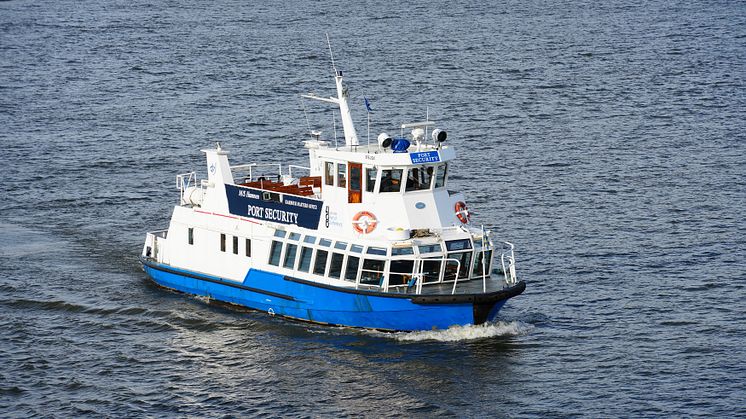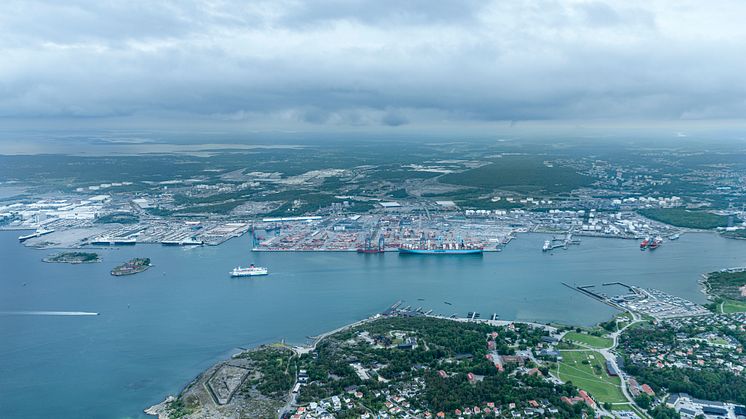
Press release -
The Port of Gothenburg’s inspection vessel to be electrified
Having been in service around the clock as an inspection vessel at the Port of Gothenburg since 1979, it’s now time for M/S Hamnen to be converted to run on electrical power. This means the vessel can be expected to remain in the port’s service for many years to come.
“The strength of M/S Hamnen is its versatility, and the fact that we’re always at hand when things happen. The vessel has many different duties, but essentially it’s there to represent the port authority and to make sure that the rules set out in the port regulations are observed,” says David Falk, skipper of M/S Hamnen.
Conversion means lower emissions than replacement
As well as being skipper of M/S Hamnen, David Falk is also project manager of the vessel’s electrification. Replacing M/S Hamnen completely was considered but deemed unnecessary.
“M/S Hamnen is in really good condition, and there’s no other vessel that’s better suited to its assignment. By converting it rather than replacing it, we further reduce emissions, as the vessel will then not be taken into use by a new owner,” says David Falk.
At present, M/S Hamnen is in operation for around 1,200 hours a year, consuming approximately 25,000 litres of diesel. This represents 67 tonnes of carbon dioxide emissions, which is 15% of the Gothenburg Port Authority’s total emissions.
Electrification – when, where and how?
The engine room will be undergoing a total transformation, as M/S Hamnen’s existing diesel engine will be replaced by a totally new electric engine with an output of 250 kW. A four to five tonne bank of batteries with 520 kWh will also be installed, and these can be supplemented by additional battery capacity in the future if required.
“In exceptional cases, special call-outs, unforeseen events or extreme weather conditions may require additional range, so we’re also installing an auxiliary diesel engine that runs on HVO. The vessel’s task is to be available in all contexts 24/7, so we need that flexibility. But the goal is to run on battery power for 90% of the time,” says David Falk.
M/S Hamnen’s regular berth position in the Port of Gothenburg will be fitted with a 63 amp charger, which is sufficient for charging between regular assignments.
M/S Hamnen will be taken to the Ö-varvet shipyard on the island of Öckerö in the Gothenburg archipelago during the spring, and will return to service in the autumn. While the vessel is laid up, David Falk and the rest of the crew will be using a smaller replacement boat to perform their inspection assignment.
A question of credibility
For the Gothenburg Port Authority, the electrification of M/S Hamnen is more than another step in the quest to achieve the port’s climate goal of a 70% reduction in port-related emissions from Vinga and over the whole Gothenburg area on the land side by 2030. That is the belief of Viktor Allgurén, Head of Innovation at the Gothenburg Port Authority.
“As far as the Gothenburg Port Authority is concerned, we have high expectations of our partners both in and around the port and the decision-makers we collaborate with when it comes to climate change, and we need to have everyone on board if we’re going to meet our goals. If we’re going to be able to demand that others contribute to the transition, we must show in all ways that we’re setting an example in the transition. It’s a question of credibility,” says Viktor Allgurén.
Facts: M/S Hamnen
Owner and operator: The Gothenburg Port Authority, through the Harbour Master’s Office and Harbour Master Åsa Kärnebro who is responsible for the vessel.
Length: 20.3 m
Width: 5.7 m
Draught: 2.6 m
Cruising speed: 8 knots
Operating hours/year: 1,200
New electric engine: 250 kW
Battery bank: 520 kWh
Range on electrical power after conversion: at least 4 hours at 6 knots
Investment: SEK 17.3 million. In addition to conversion to electrical power, a new, purpose-built wheelhouse will be installed, and a number of measures will be taken to enhance the work environment and extend the useful life.
Topics
Fact file: Port of Gothenburg
The Port of Gothenburg is the largest port in Scandinavia. Around 30% of Swedish domestic and foreign trade passes through the Port of Gothenburg and over 50% of all container traffic. The port is a full-service port, and offers industry guaranteed, climate-smart access to the whole world. Direct services to key markets ensure highly efficient, sustainable, and reliable transport 24 hours a day, 365 days a year. The focus is firmly on sustainability, innovation, and digitalisation in a concerted effort to maintain the ongoing development of climate-efficient freight transport and calls by vessels. With over 30 rail shuttles offering daily departures, companies throughout Sweden and Norway have a direct, climate-neutral service to the Port of Gothenburg. The port handles energy products, vehicles, ro-ro units, containers and passengers. 22,000 people are employed at the port.
Follow us on:
Facebook
Instagram
LinkedIn
Twitter
www.portofgothenburg.com




